Last updated on March 13th, 2022

- Canon Dual Pixel CMOS AF
- 35mm CMOS image sensor for Digital Cine Motion Imaging
- Hybrid IS (Image Stabilizer System)
- Subwavelength Structure Coating (SWC)
- DO (Diffractive Optic Element)
- IS (Image Stabilizer System)
- USM (Ultra Sonic Motor)
- EMD (Electromagnetic Diaphragm)
- Eye-controlled Autofocus
- Autofocus Area
- Anti-Fogging film
- Aspherical lenses
- Fluorite lenses
Canon Dual Pixel CMOS AF
![]() Canon Dual Pixel CMOS AF is a revolutionary new technology that unlocks the potential of Live View when capturing video and still images.
Canon Dual Pixel CMOS AF is a revolutionary new technology that unlocks the potential of Live View when capturing video and still images.
During video capture Dual Pixel CMOS AF provides natural autofocus that is reminiscent of the way the human eye focuses – like that of a camcorder – so focus transitions are smooth and subjects remain locked in even as they move.
It also enables phenomenally accurate and faster-than-ever autofocus through an LCD monitor, allowing the user to realize the unique compositional freedom of angle that Live View is capable of providing. And the compatibility of Dual Pixel CMOS AF with 103 Canon EF lenses empowers the user with exceptional optical tools for nearly limitless creative options.
![]() White paper (4.7MB)
White paper (4.7MB)
35mm CMOS image sensor for Digital Cine Motion Imaging
The new CMOS image sensor embodied in the Canon C300 digital cinema camera is based upon the established Bayer color filter array for encoding of the color components. But important advances in demosaicing algorithms have steadily improved the reconstruction of RGB video components that support the color correction and image manipulation required in postproduction. Canon explored an alternative to such reconstructive algorithms in a quest to pursue an overall image quality that aspires to achieve the superb aesthetics long associated with 35mm motion picture film.
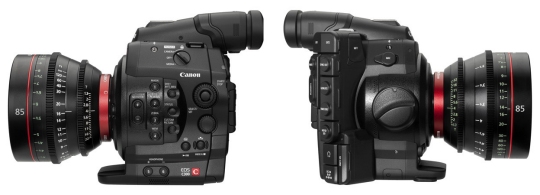
![]() White paper (1.0 MB, ENG)
White paper (1.0 MB, ENG)
Hybrid IS (Image Stabilizer System)
Canon’s research on image stabilization was started in the 80s and the world’s first optical image stabilizer for SLR cameras was introduced in 1995. Since then, Canon has made continual advancements in IS systems to improve compensation for camera shake. Now, Canon introduces its Hybrid IS system in the EF 100mm f/2.8L Macro IS USM lens. This system is designed especially for Macro Photography and it represents another step in world’s photography.
Conventional image stabilization technology is useful for reducing the effects of camera shake in non-macro shooting situations. When shooting handheld close-ups at 1x, however, it’s difficult to achieve acceptable results with conventional image stabilizers. Now, thanks to the Hybrid IS, Canon makes it easy to obtain clear close-ups where the use of a tripod is not an option.
The Hybrid IS system is able to compensate for both angular camera shake and shift camera shake. Such shakes affect both the image formed on the sensor and the image shown in the viewfinder, making it extremely difficult to record sharp images.

The Hybrid IS includes an acceleration sensor [image at right] in addition to the conventional angular velocity sensor (vibration gyro) [image at left].
Based on the amount of camera shake detected by the two distinct sensors, the algorithm calculates the amount of blur on the image plane, after which the compensating lens group is positioned — such group lays on low-friction ceramic balls.
Subwavelength Structure Coating (SWC)
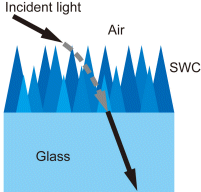 Subwavelength Structure Coating (SWC) is a new coating technology for camera lenses that minimizes ghosting and flare caused by reflected light.
Subwavelength Structure Coating (SWC) is a new coating technology for camera lenses that minimizes ghosting and flare caused by reflected light.
Reflections are caused by large changes in the refractive index of light at the glass-air boundary on the surface of a lens. To date, efforts to take advantage of light interference and minimize reflections have consisted of applying a thin film of coating onto the lens surface, but this approach can fail and sometimes leads to ghosting and flare.
Canon’s special SWC coating minimizes reflections by aligning countless wedge-shaped structures more minute than the wavelength of visible light on the surface of a camera lens.
These wedges continuously change the refractive index of light at the glass-air boundary of the lens, thereby eliminating the boundary where the index undergoes large changes. This lack of large change in the refractive index drastically reduces reflections. SWC therefore realizes superior anti-reflective capabilities in environments where previous coating technologies could not, particularly in situations involving light with a large angle of incidence.
![]() Source: Canon Global.
Source: Canon Global.
DO (Elemento ad Ottica Diffrattiva)
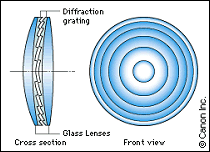 Canon introduces the first multilayered Diffractive Optic lens of the world, with the EF 400mm f/4 DO lens. The prototype will be in commerce this year.
Canon introduces the first multilayered Diffractive Optic lens of the world, with the EF 400mm f/4 DO lens. The prototype will be in commerce this year.
The optical element equipping it has the characteristics either of the fluorite lenses, and of the aspherical ones, thus representing a revolutionary evolution in photo optics.
The multilayered diffractive lenses are constructed with the goal to alter the light path inside the lenses and to not scatter part of that light as happens with normal lenses: here, in fact, all the light is forced to describe the image. Moreover, this kind of lenses correct the chromatic aberration (the different colors focus at different distances) even better than the expensive fluorite lenses, while, calibrating the spacing of the diffractive group also the spherical aberration is corrected, rendering useless the resource of the expensive aspherical lenses.
The construction of these new lenses requires a micrometric precision and three-dimensional instrumentations patented by the same Canon.
IS (Image Stabilizer) System
One of the causes of a photography failure is always has been the “moved”, so the only alternative to a tripod was the use of more sensible films or the resource to a fortune support. Canon therefore has developed an image stabilizing system, using it either in the telecameras and inserting it into the lenses. The vibrations transmitted from the hand to the camera transmit also to the lens and therefore to the optical elements. The lens movement causes the movement of the image formed, regarding the optical axis. If, therefore, the elements could move independently from the system, the problem would be resolved. This idea has been the assumption to the development of Canon’s stabilizing system.
The system is based on the connection of two vibrating gyroscopes that detect the vertical and horizontal vibrations and command an equal and contrary reaction of the sophisticated optical group assigned to the correction. The answer time of the correction is in the order of 1/2,000 of a second. It turns out a corrective effect equal to two stops in terms of exposure: the gain is therefore of two stop (equivalents to a 2 stop more luminous lens or to a 2 stop faster film) before a really moved image. The stabilization system is useful also in the panning technique (you follow a moving subject moving your camera). The software detects the movement typical of the technique and switches off the correction in the direction of the panning, keeping on only the correction of the vibration in the other directions.
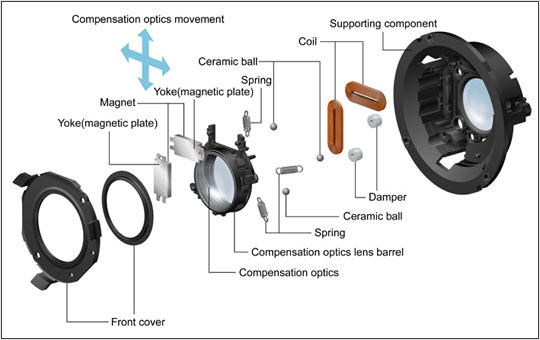
IS Mode 2: this new technology automatically determines that the movement is conscious panning and halts correction in the relevant direction, thereby preventing shake-return. The IS Mode 2 system automatically detects lack of movement / vibration to prevent operation errors when a tripod is in use. IS efficacy increases and lower overall size have been achieved through improvements in the moving contact sections of the IS lens barrel, the IS lens group barrel locking mechanism and the shake-detection gyro.
USM (Ultra Sonic Motor)

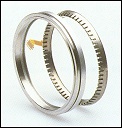 In the 1987 Canon adopted for the first time the ultrasonic motor (USM) for the autofocus lenses. The main characteristics were the high speed and the low noise, conquering the favour of all the sport- and nature- photographers of the world. Thanks to the innovation without comparisons, the manual lenses were abandoned very soon.
In the 1987 Canon adopted for the first time the ultrasonic motor (USM) for the autofocus lenses. The main characteristics were the high speed and the low noise, conquering the favour of all the sport- and nature- photographers of the world. Thanks to the innovation without comparisons, the manual lenses were abandoned very soon.
In the 1992 Canon developed an USM micromotor that could be produced industrially: currently, those USM micromotors equip nearly all the lenses of the Canon panorama.
The operation of the USM motor is based on the transmission of a vibration produced by an ultrasonic wave. Therefore, the motor ring doesn’t require neither gears, nor any electromagnetic field sources and supplies a very fast, noiseless answer with a very low energetic consumption. The range of use of the system goes from -30°C to +60°C.
EMD (Electromagnetic Diaphragm)
EMD (Electromagnetic Diaphragm) is a diaphragm drive control actuator, which is a component integrating both a stepping motor and a diaphragm blade unit in a single unit, used for fully-electronic data transmission EF mount system. Every EF lens incorporates an EMD unit as a basic component of the EOS system. EMD controls diaphragm blade by a stepping motor and aperture diameter by electronic pulse signal from the camera body to overcome the problem of conventional mechanical diaphragm units, while also provides benefits that conventional mechanism does not offer.
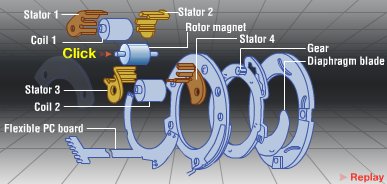
EYE-controlled Autofocus
 Canon has developed the control of the autofocus automatism through the movement of the pupil. The mechanism is set in action by the semipression of the push-button, but in this case the AF activates on the AF cell nearest the exact point where the photographer is watching through the view-finder.
Canon has developed the control of the autofocus automatism through the movement of the pupil. The mechanism is set in action by the semipression of the push-button, but in this case the AF activates on the AF cell nearest the exact point where the photographer is watching through the view-finder.
The control through the pupil happens thanks to an infrared lighting system of the pupil and to the detection of the rays reflected from the cornea and to the monitoring of the relative positions of the eye and the same pupil: this allows a sensor to calculate the bending angle of the eye and to activate the sensor in the calculated direction.
An advanced algorithm controls the variables that would cause an error: direct light on the eye, presence of glasses, tears, etc. The algorithm requires a very short initial calibration, to record the physical aspects of the eye of the photographer (or of other photographers).
Autofocus Area
 Canon continues in its search to obtain an automatic focusing function covering virtually any point of the shot. In the beginning there was the single focusing point, then they was three, then five. With the birth of the EOS-3 the points have reached the number of 45, scattered in an area of 8×15 mm. The 45 points are either vertical and horizontal and they are active also in very animated shots. This system has been installed also in the new EOS1-V, after significant testing sessions made by many professionals. The 45 points are supported by a CMOS sensor with an efficiency from 30 to 40 times better than the ordinary AF sensors.
Canon continues in its search to obtain an automatic focusing function covering virtually any point of the shot. In the beginning there was the single focusing point, then they was three, then five. With the birth of the EOS-3 the points have reached the number of 45, scattered in an area of 8×15 mm. The 45 points are either vertical and horizontal and they are active also in very animated shots. This system has been installed also in the new EOS1-V, after significant testing sessions made by many professionals. The 45 points are supported by a CMOS sensor with an efficiency from 30 to 40 times better than the ordinary AF sensors.
Anti-Fogging film
 When warm air comes in contact of a cold glass, then the humidity of the air condenses on the glass. In these conditions, lenses and view-finders can cloud and you need to wait for long time before the condenses evaporates.
When warm air comes in contact of a cold glass, then the humidity of the air condenses on the glass. In these conditions, lenses and view-finders can cloud and you need to wait for long time before the condenses evaporates.
The problem is strong for winter photographers: they must lend the highest attention not to breath on the sensitive glasses of their equipment, in order to avoid to lose important time.
The Anti-Fogging technology developed by Canon concurs to absorb condenses into a thin synthetic film deposited on the external surface of the glass. The film is composed of two polymers, one organic and one inorganic. The first one absorbs condenses, while the second prevents the disaggregation of the first and its separation from the glass. The film is also abrasion-resistant.
Aspherical lenses
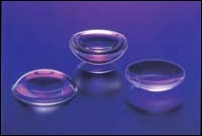 A photographic spherical element has a fundamental defect: it cannot make converge in a single fire point the parallel rays entering the element, so the optical image is not a clear image. Some standard optical groups correct the aberration, but they are not right if you want to reduce the dimensions or the weight of the system. These limits are exceeded using the aspherical optical elements, but they are difficult to construct, demanding a working accuracy equal to 0.1µm or less. In order to industrially produce the aspherical elements, Canon developed a line for the dedicated construction, thanks also to the use of control instruments with a precision of 0.02µm (laser interferometer) and to machines for the aspherical working never constructed before. Canon has then perfected the system, differentiating the workings on the base of photographic requirements.
A photographic spherical element has a fundamental defect: it cannot make converge in a single fire point the parallel rays entering the element, so the optical image is not a clear image. Some standard optical groups correct the aberration, but they are not right if you want to reduce the dimensions or the weight of the system. These limits are exceeded using the aspherical optical elements, but they are difficult to construct, demanding a working accuracy equal to 0.1µm or less. In order to industrially produce the aspherical elements, Canon developed a line for the dedicated construction, thanks also to the use of control instruments with a precision of 0.02µm (laser interferometer) and to machines for the aspherical working never constructed before. Canon has then perfected the system, differentiating the workings on the base of photographic requirements.
Fluorite lenses
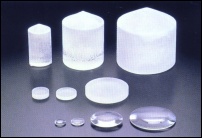 The subdivision of the light in different colors (wavelengths) causes the chromatic aberration during light passaging through a conventional element: the different colors are focused at different distances, causing a chromatic under-focusing. In order to correct it, it’s a necessity an optical group constituted by a convex and a concave lenses: it works good, but it doesn’t correct the green spectrum. For this reason, Canon has constructed the fluorite lenses, in order to focus all the colors in the same point nearly to the perfection. Fluorite (CaF2) is a mineral with particular features, as the low refraction index and a low dispersion, but in nature is not diffused and large enough to drawn industrial lenses.
The subdivision of the light in different colors (wavelengths) causes the chromatic aberration during light passaging through a conventional element: the different colors are focused at different distances, causing a chromatic under-focusing. In order to correct it, it’s a necessity an optical group constituted by a convex and a concave lenses: it works good, but it doesn’t correct the green spectrum. For this reason, Canon has constructed the fluorite lenses, in order to focus all the colors in the same point nearly to the perfection. Fluorite (CaF2) is a mineral with particular features, as the low refraction index and a low dispersion, but in nature is not diffused and large enough to drawn industrial lenses.
For this reason, Canon developed in 1969 a process of synthetic crystallization of the fluorite and produced the first lens equipped of a fluorite element. Currently, nearly all the telephoto lenses and the professional zooms mount a fluorite element. A particular care is required in the working phases (grinding and polishing), that need sophisticated technologies: microscopical diamond abrasion in order to achieve a polishing with a ruvidity under the 0.002µm.
Copyright, Authorship, and Ownership statements
All text and images are copyright ©️ Chrysis.net unless otherwise stated - please see individual cases for authorship and copyright details. The specimens pictured are from the authors' or other collaborators' personal collections and from the collections of various museums. Unless otherwise specified, the whole content of this web site is for personal, non-commercial, scientific, and educational purposes given proper accreditation to the page from which they were derived are provided, and under Chrysis.net Terms and Conditions.
For citation purposes
Agnoli G.L. (2024) Canon EOS technology, in: Chrysis.net website. Interim version 27 July 2024, URL: https://www.chrysis.net/photography/canon-eos-technology/.




